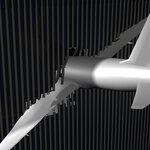Applied Physics

Plants absorb carbon dioxide from the air and combine it with water molecules and sunshine to make carbohydrate or sugar. Variations on this process provide fuel for all of life on Earth.
University of Wisconsin-Madison chemical and biological engineering Professor James Dumesic and his research team describe a two-stage process for turning biomass-derived sugar into 2,5-dimethylfuran (DMF), a liquid transportation fuel with 40 percent greater energy density than ethanol.
The prospects of diminishing oil reserves and the threat of global warming caused by releasing otherwise trapped carbon…

Materials that change temperature in magnetic fields could lead to new refrigeration technologies that reduce the use of greenhouse gases, thanks to new research at the U.S. Department of Energy's Argonne National Laboratory and Ames National Laboratory.
Scientists carrying out X-ray experimentation at the Advanced Photon Source at Argonne — the nation's most powerful source of X-rays for research — are learning new information about magnetocaloric materials that have potential for environmentally friendly magnetic refrigeration systems.
Magnetic refrigeration is a clean technology that…

Solving one of the biggest problems in commercialization of fuel-cell-powered automobiles is the goal of a new $1.88 million research project on on-board hydrogen storage at the U.S. Department of Energy's Argonne National Laboratory.
To be practical, researchers say, the hydrogen storage system must be able to hold enough of the fuel for a driving range of 300 miles before refilling; no current technology meets this goal within the constraints of allowable weight and volume for passenger cars.
The Argonne research will investigate nanostructured polymeric materials as hydrogen storage…

Researchers at Rensselaer Polytechnic Institute and the University of Akron have created synthetic “gecko tape” with four times the sticking power of the real thing.
The researchers describe a process for making polymer surfaces covered with carbon nanotube hairs. The nanotubes imitate the thousands of microscopic hairs on a gecko’s footpad, which form weak bonds with whatever surface the creature touches, allowing it to “unstick” itself simply by shifting its foot.
For the first time, the team has developed a prototype flexible patch that can stick and unstick repeatedly with properties…

Engineers at Purdue University are developing robots able to make "educated guesses" about what lies ahead as they traverse unfamiliar surroundings, reducing the amount of time it takes to successfully navigate those environments.
The method works by using a new software algorithm that enables a robot to create partial maps as it travels through an environment for the first time. The robot refers to this partial map to predict what lies ahead.
The more repetitive the environment, the more accurate the prediction and the easier it is for the robot to successfully navigate, said C.S. George Lee…
If you have bad kids, it may not be your fault.
Well, it could still be your fault, because it's biology and genetics is part of biology, but you can't control genetics. At least you then you wouldn't have to feel guilty about being a lousy parent.
Either way there's a real effort on to blame everything except the actual delinquent kids and a new study in Psychological Science advances that cause. Rutgers University psychologist Daniel Hart and colleagues write that they can use a a Skin Conductance Response (SCR) test, along with some family history, to predict delinquency.
The…

Although most Americans believe they know what brought down the World Trade Center twin towers on Sept. 11, 2001, civil engineers are still seeking answers to questions that could save lives in the future.
Structural engineers need to know from a scientific perspective what happened to the buildings during the terrorist attacks in order to prevent future failures.
The search for answers continues with the help of a state-of-the-art animated visualization created by researchers at Purdue University.
Source: Purdue University
Christoph Hoffmann, a professor of computer science and director of…

Buried beneath a sulfurous cauldron in European seas lies a class of microorganisms known as “extremophiles,” so named because of the extreme environmental conditions in which they live and thrive. Almost as radical, perhaps, is the idea that these organisms and their associated enzymes could somehow unlock the key to a new transportation economy based on a renewable biofuel, lignocellulosic ethanol.
They're called extremophiles for a reason. Courtesy: University of New South Wales
That’s the concept behind an internally funded research program at Sandia National Laboratories, now in its…

Using an ocean of data, sophisticated mathematical models and supercomputing resources, researchers at the Department of Energy’s Oak Ridge National Laboratory are putting climate models to the test with particular focus on weather extremes.
Ultimately, the new methodology developed by Auroop Ganguly and colleagues could help determine to what extent there is a connection between human activity and climate change. For now, however, researchers are concentrating on how climate models fare when compared to actual observations recorded between 1940 and 2005 and whether there are any connections…

Want to play the ultimate version of The X-Men's "Wolverine" this Halloween? You'll need self-healing skin after those claws come out. Researchers at the University of Illinois are here to help. They have invented the next generation of self-healing materials, which mimics human skin by healing itself time after time. The new materials rely upon embedded, three-dimensional microvascular networks that emulate biological circulatory systems.
Now they just need to invent that Adamantium exo-skeleton. Copyright Marvel Comics Group
“In the same manner that a cut in the skin triggers blood…